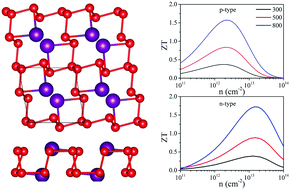Promising thermoelectric candidate based on a CaAs3 monolayer: A first principles study†
Abstract
The CaAs3 monolayer is a newly predicted two-dimensional material with attractive properties, such as a moderate direct bandgap, high carrier mobility, prominent visible-light absorption, etc. To evaluate its potential applications in thermoelectric (TE) fields, herein, the thermoelectric properties of CaAs3 monolayers were comprehensively investigated by a first-principles method in combination with Boltzmann transport theory. Our calculated results indicate that the CaAs3 monolayer has an exceptionally low lattice thermal conductivity of 0.44 W m−1 K−1 at 300 K, mainly because of the small group velocity and strong phonon–phonon scattering. The CaAs3 monolayer also exhibits a high power factor due to the large Seebeck coefficient and electrical conductivity. Therefore, large ZT values of 1.72/1.58 were achieved for the n-type/p-type CaAs3 monolayer at 800 K. Compared with conventional 2D TE materials, the CaAs3 monolayer does not contain expensive heavy elements, which is beneficial for its practical applications as a TE material. Our results qualify the CaAs3 monolayer as a promising candidate for building excellent 2D TE devices.



 Please wait while we load your content...
Please wait while we load your content...